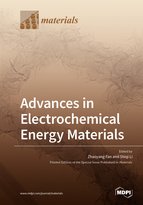Advances in Electrochemical Energy Materials
A special issue of Materials (ISSN 1996-1944). This special issue belongs to the section "Energy Materials".
Deadline for manuscript submissions: closed (31 December 2019) | Viewed by 49051
Special Issue Editors
Interests: semiconductor materials; electronic devices; nanomaterials; energy storage
Special Issues, Collections and Topics in MDPI journals
Interests: lithium–sulfur batteries; lithium-ion batteries; supercapacitors; microwave chemistry
Special Issues, Collections and Topics in MDPI journals
Special Issue Information
Dear Colleagues,
Electrochemical energy storage and conversion systems are becoming essential for electrified transportation, integration of intermittent renewable energy into grids, non-fossil and green fuel production, and many other energy or power applications. The electrode materials and structures, in addition to the liquid or solid electrolytes, play key roles in supporting a multitude of coupled physicochemical processes that include electronic, ionic, and diffusive transport in electrode and electrolyte phases, electrochemical reactions and material phase changes, as well as mechanical and thermal stresses, thus determining the storage energy density and power density, conversion efficiency, performance lifetime, and system cost and safety. Different material chemistries and multiscale porous structures are being investigated towards high performance and low cost. The aim of this Special Issue is to report recent advances related to materials used either in electrochemical energy storage, which encompasses supercapacitors and Li ion, Na ion, or other rechargeable batteries, or in electrochemical energy conversion, which includes electrocatalysts, green fuel production, fuel cells, etc. We are confident that publication of such a Special Issue will stimulate the imagination of researchers to develop advanced materials to further enhance the performance of electrochemical energy devices and put forward their practical application.
It is our pleasure to invite you to submit a manuscript reporting novel materials and structures, their electrochemical behaviors, fundamental mechanisms, novel device concepts, as well as other related topics for this Special Issue. Full papers, communications, and reviews are all welcome.
Prof. Zhaoyang Fan
Assoc. Prof. Shiqi Li
Guest Editors
Manuscript Submission Information
Manuscripts should be submitted online at www.mdpi.com by registering and logging in to this website. Once you are registered, click here to go to the submission form. Manuscripts can be submitted until the deadline. All submissions that pass pre-check are peer-reviewed. Accepted papers will be published continuously in the journal (as soon as accepted) and will be listed together on the special issue website. Research articles, review articles as well as short communications are invited. For planned papers, a title and short abstract (about 100 words) can be sent to the Editorial Office for announcement on this website.
Submitted manuscripts should not have been published previously, nor be under consideration for publication elsewhere (except conference proceedings papers). All manuscripts are thoroughly refereed through a single-blind peer-review process. A guide for authors and other relevant information for submission of manuscripts is available on the Instructions for Authors page. Materials is an international peer-reviewed open access semimonthly journal published by MDPI.
Please visit the Instructions for Authors page before submitting a manuscript. The Article Processing Charge (APC) for publication in this open access journal is 2600 CHF (Swiss Francs). Submitted papers should be well formatted and use good English. Authors may use MDPI's English editing service prior to publication or during author revisions.
Keywords
- rechargable betteries
- supercapacitors
- fuel cells
- electrocatalyst
- electrode materials
- nanostructure
- electrochemical energy
- energy storage
- energy conversion








